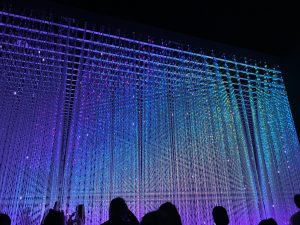Teamlab’s Future World exhibition was a beautiful showcase of the intersection between art and science. My favourite exhibit was Space. The use of LED lights and mirrors created a beautiful optical illusion that you were in an infinity room. The use of light and reflection was brilliantly used to make you feel like you were flying through outer space itself.

City in a Garden pays homage to the Garden City movement. It celebrates the flora and fauna of Singapore and how it is all part of an interwoven circle of life. I loved how Transcending Boundaries utilized butterflies to connect all six pieces and how if you touch the butterfly projection, it will die. It is an interesting narrative about how humans affect the circle of life. The room itself brings you into the circle of life; there is a constantly state of flow and harmony brought together by the blooming flowers, flowing river, and butterflies. Every time I looked around, there was a different rotation of nature being projected.
This was a wonderful experience that transported me into another world. It was a beautiful mix of artwork showcase and user interactivity. Team Lab artistically used both visual and audio stimuli to transport you into the Future World.

